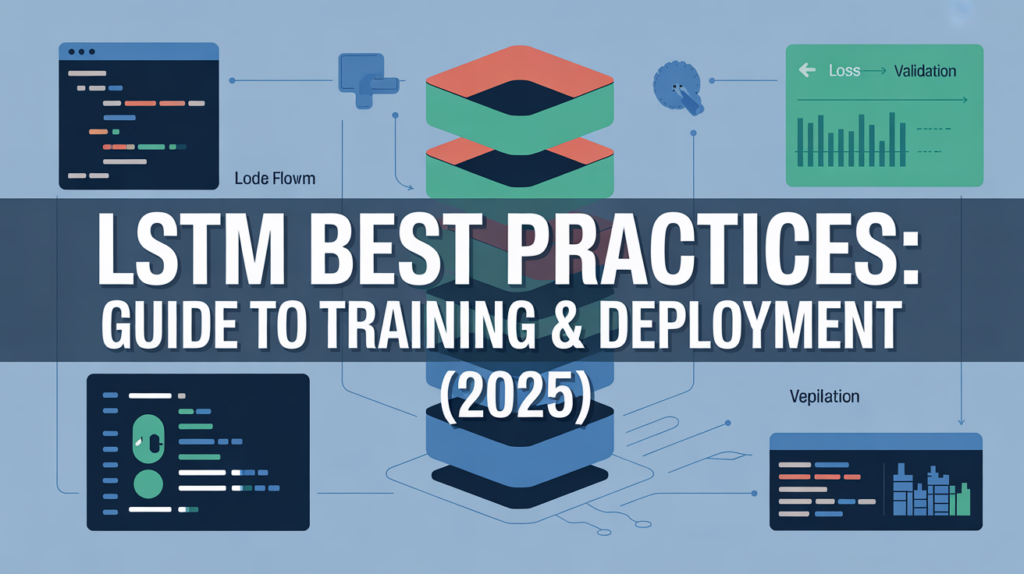LSTM Best Practices: Guide to Training & Deployment (2025)

Introduction to LSTM Best Practices
If you’re building sequence models with LSTM, following lstm best practices can dramatically improve accuracy, efficiency, and reliability. This guide covers every stage: data preprocessing, architecture design, training strategies, hyperparameter tuning, optimization, debugging, deployment, and monitoring. Real-world examples using Python, Keras, and TensorFlow help illustrate the core guidelines for robust LSTM implementation in 2025.
1. Preprocessing & Data Pipeline Best Practices
1.1 Sequence Scaling & Normalization
Normalize time-series inputs using MinMaxScaler or StandardScaler to stabilize gradients and improve convergence. For NLP, use consistent tokenization and padding to fixed sequence length.
1.2 Window & Batch Construction
Use sliding windows (e.g., past 50–100 timesteps) for regression tasks or pad/truncate text consistently. Build efficient input pipelines using tf.data for batching, shuffling, and caching—crucial for lstm best practices training.
External resource: TensorFlow time-series tutorial → tensorflow.org tutorials
2. Architecture & Model Design Guidelines
2.1 Choosing Layers & Units
Start with a single LSTM layer of 64–128 units. Avoid over-parameterization, especially with small datasets. Stacked architectures or bidirectional layers can help—only if supported by validation performance.
2.2 Regularization Techniques
Apply both dropout and recurrent_dropout. Use weight decay (L2 regularization) and consider batch normalization in deeper models to stabilize training—essential elements of lstm best practices implementation.
3. Training Strategies & Hyperparameter Tuning
3.1 Learning Rate Scheduling
Use adaptive optimizers (AdamW, RAdam) and learning rate decay (cosine schedule, warm restarts). Integrate early stopping based on validation loss to avoid overfitting.
3.2 Hyperparameter Search
Tune key parameters: batch size (16–64), timestep window length, number of hidden units, learning rate, dropout rate. Use grid or random search with cross-validation—core practice in lstm best practices hyperparameters.
4. Optimization & Debugging Techniques
4.1 Gradient Clipping
Control exploding gradients (especially in deep/sequential models) by clipping global norm or value to a threshold (e.g., 1.0). Essential for stable lstm best practices optimization.
4.2 Gate Activation Monitoring
Track gate saturation using custom callbacks. Use plots of input/forget gates over time to detect vanishing information or stuck gates—key debugging practice.
4.3 Loss & Metric Visualization
Plot training vs validation curves for loss and accuracy. Use TensorBoard or WandB to track numerical drift—helping to identify divergence or slow convergence early.
5. Performance & Resource Optimization
5.1 Mixed‑Precision & Quantization
Use TensorFlow mixed-precision (float16) or convert to TFLite for lighter deployment when using lstm best practices deployment approaches.
5.2 Batch Size vs Sequence Length Trade-off
Optimize for GPU memory by balancing batch size and sequence length. Sequence length affects gradient memory; batching affects throughput.
6. Deployment, Monitoring & Maintenance
6.1 Model Export & Versioning
Export your model using tf.saved_model or TFLite format. Use version control with Git and maintain model metadata (hyperparameters, dataset version) for reproducibility.
6.2 Real‑Time Monitoring & Retraining
Hook monitoring dashboards (TensorBoard.dev or WandB) for active drift detection in deployed models. Set up triggers to retrain if meaningful accuracy drop occurs—a best practice in production usage.
7. Real-World Examples of Applying Best Practices
7.1 Time-Series Forecasting (e.g., Energy Demand Prediction)
Using normalized historical load, weather and timestamp features: LSTM with two layers + dropout, clipped gradients, early stopping—resulting in <3% forecast error. Gate activation plots helped tweak dropout rates.
7.2 NLP Classification (e.g., Support Ticket Prioritization)
Workflow: Text → Tokenization → Embedding → LSTM → Dense head. Use early stopping, class weighting, and validation-based scheduling. Final model achieved 90% accuracy with minimal overfitting, aided by careful architecture tuning.
8. Common Mistakes and How to Avoid Them
| Mistake | How to Fix |
|---|---|
| No normalization on time-series | Always scale sequences to consistent range |
| Missing recurrent dropout | Add recurrent_dropout=0.2 along with input dropout |
| Using full sequence history without tuning | Optimize sliding window length for task |
| Ignoring gate saturation | Visualize and adjust initial weights or dropout settings |
| Deploying without monitoring | Set up validation metric trigger thresholds for retraining |
🏷️ External Links & Further Resources
- Official TensorFlow guide to LSTM modeling: tensorflow.org recurrent tutorial
- Keras recurrent layer reference (dropout and implementation options): keras.io LSTM docs
- Olah’s visual guide to LSTMs and gates: colah.github.io post
- WandB monitoring platform: wandb.ai
✅ Frequently Asked Questions (FAQs)
- What is the single most important best practice for LSTM?
Normalizing input data and using dropout with early stopping to prevent overfitting stand out as critical. - How should I choose the number of LSTM layers?
Start simple with one layer. Only add stacking if validation loss improves and overfitting is controlled. - Can LSTM handle both long and short sequences?
Yes—optimize sliding window length and batch size based on memory constraints and gradient flow. - Why is gradient clipping necessary for LSTM training?
It prevents unstable training by bounding large parameter updates during backpropagation through time. - How do I monitor a model in production?
Use tools like TensorBoard.dev or WandB for drift detection and set thresholds to trigger periodic retraining.
Discover more from Neural Brain Works - The Tech blog
Subscribe to get the latest posts sent to your email.
